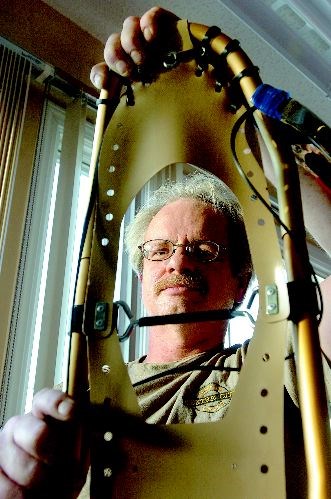These days, people can get away with sneakers down at Prince George level, but not far up in elevations where it is still snowshoe country.
There is even more snow than usual at this time of year in the timbered terrain where forestry and mining work is done.
So it's still a busy season at the snowshoe factory of Industrial Reproductions Ltd. (IRL) on the north shore of the Nechako River.
"A lot of our sales occur in late winter," said IRL spokesman Steve Mayoh. "There is often a lot of industry going on out in the backcountry this time of year. And if the guys have toughed it out all winter long on one set of snowshoes, but the wear and tear is catching up on them, we see them come in and pick up a new set now. They just don't want to risk it out there."
The IRL shoes are a little more skookum than what the casual hiker would buy at a sports store.
"They [timber cruisers, surveyors, mining explorers] can't afford something to go wrong out there," Mayoh said. "They are using axes, painting, climbing rough terrain, they need something robust, easy to repair, dependable."
IRL manufactures several industrial products at their facility, and their own line of snowshoes is now 10 years old. But the company's history with snowshoes started long before that.
They were called on frequently to do repairs, especially for the industrial community's first choice, the Sherpa shoe.
When Sherpa went out of business in the 1990s, IRL customers begged them for an alternative. It didn't exist, so they ordered in the pipes and claws and laces to do it themselves.
"A lot of companies shy away from the manufacturing but it has been a boost for us," he said. "Yes there is extra work up front and some resources we have to acquire. It takes up space and it takes up staff time. We had a lot of trial and error at the start, and we still have some each year. But it is a very helpful product.
"It solves a problem for our customers, who were coming to us for other things anyway, so it puts us in more direct contact with them."
At the start of each winter they like to have about 150 sets of IRL snowshoes pre-made during the off season.
Then two primary staff people -- Dave Hughes and Don Davis, plus others on a part-time basis -- hand lace more together during the winter. Depending on the weather they will sell anywhere from 300 to 500 sets, plus a regimen of repairs. Even some Sherpas still come through the door.
IRL was one of the businesses that suffered directly from the downturn in the economy, due to the recession's roots in raw resources. The snowshoe line survived this, partially due to a growing international reputation.
A customer base is growing in the United States and Mayoh said "we sent six pairs to Norway just yesterday."
Also growing is interest from the recreational winter hiking community.
The Ministry of Environment's Prince George-based flood forecaster, Lyle Larsen, just got back from the monthly snowpack survey and confirmed the pile of white is still high out in the mountains.
"Down in the bowl, where there is a lot of concrete and pavement so it melts off a lot quicker but if you go out in the bush there is still half a meter of snow or more," Larsen said. "The average depth of snow around the area on April 1 is 39 cms, but this year on April 1 we were at 63 cms."
If anyone has to walk out there, snowshoes will still be the fashionable attire for at least a few weeks.



